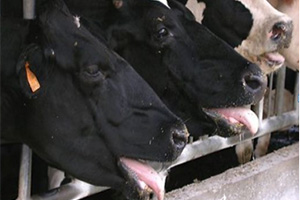Managing Heat Stress
Jun 10, 2025

Summer heat stress has already tested us, are you ready for when it hits for real? Heat stress has been a bit of a moving target – as our cows get bigger, make more milk, and eat more. The threshold for heat stress has dropped from 72° to 67° and now folks are talking about 65°. Weather in general has gotten warmer the past several years. Both combine to make more days of heat stress.
As long as we get cool nights – below 65°, the cows can recover some – shifting eating patterns to eat more during the cool of the night and milk can stay almost normal. Once we lose night cooling, the stress is constant throughout the day and the cows can’t compensate enough. Those effects “accumulate” – recovery time is slower after each new hot spell. The most obvious sign of heat stress is a drop of 3-7 lbs. of milk per cow per day. Unfortunately, by then a lot of negative things have already happened and it isn’t just the milk cows that are affected.
Repeated studies at the University of Florida have shown that the calves from dry cows that have been heat-stressed are 12%-14% lighter than calves born at the same time to cows that had good cooling. More research showed that those smaller calves did not milk as well in their first lactation as the offspring of cows that were not heat stressed during the dry period. Even the offspring of those calves that were born under heat stress did not perform as well as those that were from the dry cows that did not experience heat stress. So, the effect of one season’s heat stress can impact multiple generations.
Ways to stay ahead of heat stress:
1) Look for signs of heat stress. The most obvious sign of heat stress is rapid respiration rate. Watch the cows breathe. Normal respiration rate for a cow under thermoneutral conditions is 45-45 breaths/minute. If their respiration rate is over 60 breaths/minute, they are experiencing heat stress. You can also use an infrared (IR) thermometer/gun to measure the skin temperature of the upper udder. Temperatures above 96.5° indicate heat stress.
2) Look in the right places – anytime animals bunch up, their body temperatures will go up. The holding area going into the parlor is usually the first place you see cows experiencing heat stress. Poorly ventilated places (like old stanchion barns where dry cows often live) also get hot quicker. Open lots with no shade are another stress area.
3) Manage heat stress – Add fans first, sprinklers later if you have the opportunity. Fans over stalls first – allows them to lie down more hours and rest their feet. Fans over the feed alley will encourage more eating but also more standing. Sprinklers work well during dry weather WITH fans to help with evaporative cooling. There is little evaporation of water from the skin on high-humidity days/little cooling. Cows bunch together when heat stressed – always in a dark part of the barn. Play with curtain settings to give cows more shaded area and encourage them to spread out. DON’T FORGET WATERERS. Provide at least 3” of water space/cow. Adding a water tub can be a good move with little investment. Feed more at night – cows will eat more during the cooler part of the day, don’t let them run out of feed in the middle of the night.
What else? We typically increase the energy and protein density of the total mixed ration (TMR) to make up for the drop in feed intake. This will NOT get all of your milk back. There are a lot of other things going on metabolically in the cow that suck up extra energy. Increasing buffer in the ration and adding yeast can help modulate the rumen. Adding more potassium to the ration is an economical way to provide more electrolytes. We also offer a new product for heat stress – Fortiva Cool Cow – providing betaine to maintain hydration of the cow, live yeast for rumen modulation, and MOS and beta glucans to help immune function. Betaine is a partial alternative to electrolytes – minimizing electrolyte loss. Betaine also helps reduce shrink on animals being transported. The betaine can start working in a couple of days, for the full benefit of the added yeast, feed for 30 days. Contact your Allied Cooperative feed representative for more information and pricing.